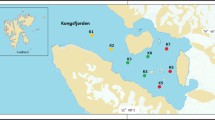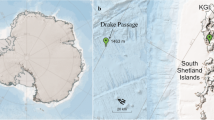Abstract
Few studies have addressed the occurrence of fungi in deep-sea sediments, characterized by elevated hydrostatic pressure, low temperature, and fluctuating nutrient conditions. We evaluated the diversity of fungi at three locations of the Central Indian Basin (CIB) at a depth of ~5,000 m using culture-independent approach. Community DNA isolated from these sediments was amplified using universal and fungal-specific internal transcribed spacers and universal 18S rDNA primer pairs. A total of 39 fungal operational taxonomic units, with 32 distinct fungal taxa were recovered from 768 clones generated from 16 environmental clone libraries. The application of multiple primers enabled the recovery of eight sequences that appeared to be new. The majority of the recovered sequences belonged to diverse phylotypes of Ascomycota and Basidiomycota. Our results suggested the existence of cosmopolitan marine fungi in the sediments of CIB. This study further demonstrated that diversity of fungi varied spatially in the CIB. Individual primer set appeared to amplify different fungal taxa occasionally. This is the first report on culture-independent diversity of fungi from the Indian Ocean.





Similar content being viewed by others
References
Altschul SF, Gish W, Miller W, Myers EW, Lipman DJ (1990) Basic local alignment search tool. J Mol Biol 215:403–410
Bass D, Howe A, Brown N, Barton H, Demidova M, Michelle H, Li L, Sander H, Watkinson SC, Willcock S, Richards TA (2007) Yeast forms dominate fungal diversity in the deep oceans. Proc R Soc B 274:3069–3077
Bauer R, Oberwinkler F (1991) The colacosomes: new structures at the host- parasite interface of a mycoparasitic basidiomycete. Bot Acta 104:53–57
Burgaud G, Calvez TL, Arzur D, Vandenkoornhuyse P, Barbier G (2009) Diversity of culturable marine filamentous fungi from deep-sea hydrothermal vents. Environ Microbiol 11:1588–1600
Calvez TL, Burgaud G, Mahe S, Barbier G, Vandenkoornhuyse P (2009) Fungal diversity in deep-sea hydrothermal ecosystems. Appl Environ Microbiol 75:6415–6421
Cantrell SA, Casillas-Martinez L, Molina M (2006) Characterization of fungi from hypersaline environments of solar salterns using morphological and molecular techniques. Mycol Res 110:962–970
Cole JR, Chai B, Farris RJ, Wang Q, Kulam SA, McGarrell DM, Garrity GM, Tiedje JM (2004) The Ribosomal Database Project (RDP-II): sequences and tools for high-throughput rRNA analysis. Nucleic Acids Res 33:D294–D296
Damare S, Raghukumar C, Raghukumar S (2006) Fungi in deep-sea sediments of the Central Indian Basin. Deep-Sea Res PT 1 53:14–27
Damare SR, Nagarajan M, Raghukumar C (2008) Spore germination of fungi belonging to Aspergillus species under deep-sea conditions. Deep-Sea Res PT I 55:670–678
Gaddanho M, Sampaio JP (2006) Microeukaryotic diversity in the extreme environments of the Iberian Pyrite Belt: a comparison between universal and fungi-specific primer sets, temperature gradient gel electrophoresis and cloning. FEMS Microbiol Ecol 57:139–148
Gadd G, Watkinson SC, Dyer PS (2007) Fungi in the environment. Cambridge University Press, Cambridge
Gao Z, Li B, Zheng C, Wang G (2008) Molecular detection of fungal communities in the Hawaiian marine sponges Suberites zeteki and Mycale armata. Appl Environ Microbiol 74:6091–6101
Gardes M, Bruns TD (1993) ITS primers with enhanced specificity for basidiomycetes—application to the identification of mycorrhizae and rusts. Mol Ecol 2:113–118
Harvell CD, Mitchell CE, Ward JR, Altizer S, Dobson AP, Ostfeld RS, Samuel MD (2002) Climate warming and disease risks for terrestrial and marine biota. Science 296:2158–2162
Jebaraj CS, Raghukumar C, Behnke A, Stoeck T (2010) Fungal diversity in oxygen-depleted regions of the Arabian Sea revealed by targeted environmental sequencing combined with cultivation. FEMS Microb Ecol 71:399–412
Jones EBG, Sakayaroj J, Suetrong S, Somrithipol S, Pang KL (2009) Classification of marine Ascomycota anamorphic taxa and Basidiomycota. Fungal Divers 35:1–187
Kumar S, Nei M, Dudley J, Tamura K (2008) MEGA: a biologist-centric software for evolutionary analysis of DNA and protein sequences. Brief Bioinform 9:299–306
Kuncic KM, Kogej M, Drobne D, Gunde-Cimerman N (2010) Morphological response of the halophilic fungal genus Wallemia to high salinity. Appl Environ Microbiol 76:329–337
Lai X, Cao L, Tan H, Fang S, Huang Y, Zhou S (2007) Fungal communities from methane hydrate-bearing deep-sea marine sediments in South China Sea. ISME J 1:756–762
Levin LA, Etter RJ, Rex MA, Gooday AJ, Smith CR, Pineda J, Stuart CT, Hessler RR, Pawson D (2001) Environmental influences on regional deep-sea species diversity. Annu Rev Ecol Syst 132:51–93
Liu WC, Li CQ, Zhu P, Yang JL, Cheng KD (2010) Phylogenetic diversity of culturable fungi associated with two marine sponges: Haliclona simulans and Gelliodes carnosa, collected from the Hawaiian Island coastal waters of the South China Sea. Fungal Divers 42:1–15
Lopez-Garcia P, Philippe H, Gail F, Moreira D (2003) Autochthonous eukaryotic diversity in hydrothermal sediment and experimental microcolonizers at the Mid-Atlantic Ridge. Proc Natl Acad Sci USA 2:697–702
Lopez-Garcia P, Rodriguez-Valera F, Pedros-Alio C, Moreira D (2001) Unexpected diversity of small eukaryotes in deep-sea Antarctic plankton. Nature 409:603–607
Moon-van der Staay SY, DeWachter R, Vaulot D (2001) Oceanic 18S rDNA sequences from picoplankton reveal unsuspected eukaryotic diversity. Nature 409:607–610
Moreira D, Lopez-Garcia P (2003) Are hydrothermal vents oases for parasitic protists? Trends Parasitol 19:556–558
O’Brien H, Parrent JL, Jackson JA, Moncalvo J, Vilgalys R (2005) Fungal community analysis by large-scale sequencing of environmental samples. Appl Environ Microbiol 71:5544–5550
Ohta Y, Hatada Y (2006) A novel enzyme, λ-carrageenase, isolated from a deep-sea bacterium. J Biochem 140:475–481
Paz Z, Komon-Zelazowska M, Druzhinina IS, Aveskamp MM, Shnaiderman A, Aluma Y, Carmeli S, Ilan M, Yarden O (2010) Diversity and potential antifungal properties of fungi associated with Mediterranean sponge. Fungal Divers 42:17–26
Raghukumar C, Raghukumar S, Sheelu G, Gupta SM, Nath BN, Rao BR (2004) Buried in time: culturable fungi in a deep-sea sediment core from the Chagos Trench, Indian Ocean. Deep-Sea Res PT 1 51:1759–1768
Schloss PD, Westcott SL, Ryabin T, Hall JR, Hartmann M, Hollister EB, Lesniewski RA, Oakley BB, Parks DH, Robinson CJ, Sahl JW, Stres W, Thallinger GG, Horn DJV, Weber CF (2009) Introducing mothur: open source, platform-independent, community-supported software for describing and comparing microbial communities. Appl Environ Microbiol 75:7537–7541
Shao Z, Sun F (2007) Intracellular sequestration of manganese and phosphorous in a metal-resistant fungus Cladosporium cladosporioides from deep-sea sediment. Extremophiles 11:435–443
Singh P, Raghukumar C, Verma P, Shouche Y (2010) Phylogenetic diversity of culturable fungi from the deep-sea sediments of the Central Indian Basin and their growth characteristics. Fungal Divers 40:89–102
Snelgrove PVR, Blackburn TH, Hutchings P, Alongi D, Grassle JF, Hummel H, King G, Koike I, Lambshead PJD, Ramsing NB, Solis-Weiss V, Freckman DW (1997) The importance of marine sediment biodiversity in ecosystem processes. Ambio 26:578–582
Sogin M, Morrison HG, Huber JA, Welch DM, Huse SM, Neal PR, Arrieta JM, Herndl GJ (2006) Microbial diversity in the deep sea and underexplored “rare biosphere”. Proc Natl Acad Sci USA 103:12115–12120
Synnes M (2007) Bioprospecting of organisms from deep sea: scientific and environmental aspects. Clean Techn Environ Policy 9:53–59
Takishita K, Tsuchiya M, Reimer JD, Maruyama T (2006) Molecular evidence demonstrating the basidiomycetous fungus Cryptococcus curvatus is the dominant microbial eukaryote in sediment at the Kuroshima Knoll methane seep. Extremophiles 10:165–169
Thompson JD, Higgins DG, Gibson TJ (1994) CLUSTAL W: improving the sensitivity of progressive multiple sequence alignment through sequence weighting, positions-specific gap penalties and weight matrix choice. Nucleic Acids Res 22:4673–4680
Toth M, Smith C, Frase H, Mobashery S, Vakulenko S (2010) An antibiotic-resistance enzyme from a deep-sea bacterium. J Am Chem Soc 132:816–823
Van Dover CL, Ward ME, Scott JL, Underdown J, Anderson B, Gustafson C, Whalen M, Carnegie RB (2007) A fungal epizootic in mussels at a deep-sea hydrothermal vent. Marine Ecol 28:54–62
Vanreusel A, Fonseca G, Danovaro R (2010) Contribution of deep-sea macrohabitat heterogeneity to global nematode diversity. Marine Ecol 31:6–20
White TJ, Bruns TD, Lee S, Taylor JW (1990) Amplification and direct sequencing of fungal ribosomal RNA genes for phylogenetics. Academic press, San Diego, CA, pp 315–324
Acknowledgements
The first author is thankful to University Grants Commission for the award of Senior Research Fellowship and to Dr. Rahul Sharma, NIO, Goa, for the facilities extended during the research cruise. Dr. S. Raghukumar's untiring effort in improving this manuscript is greatly acknowledged. The crew members of the Russian research vessel Academic Borris Petrov are acknowledged for their support. The first two authors are grateful to the Director, NIO, for the support extended. The authors are grateful to the three anonymous reviewers for helping to improve the scientific quality of our manuscript. NIO's contribution No. 4861.
Author information
Authors and Affiliations
Corresponding author
Rights and permissions
About this article
Cite this article
Singh, P., Raghukumar, C., Verma, P. et al. Fungal Community Analysis in the Deep-Sea Sediments of the Central Indian Basin by Culture-Independent Approach. Microb Ecol 61, 507–517 (2011). https://doi.org/10.1007/s00248-010-9765-8
Received:
Accepted:
Published:
Issue Date:
DOI: https://doi.org/10.1007/s00248-010-9765-8




